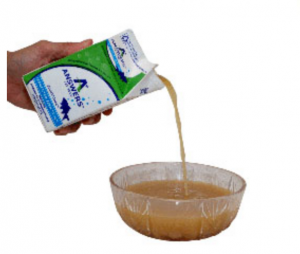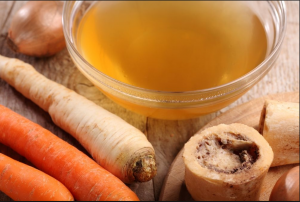Bone Broth
This is the second segment in a series covering the benefits of whole food toppers. We try to source the very best dry pet foods on the market, but the truth is that all kibble diets are highly processed foods. Multiple heat processing steps during production damage valuable nutrients like amino acids, enzymes and vitamins, and can create chemicals like acrylamide . Adding small amounts of whole foods to your dry food as toppers can provide valuable nutrients that can help to support their health. It’s amazing how often adding whole foods to processed food diets can help to clear up nagging chronic health problems like itchy skin and other irritations. Don’t miss the introductory blog post in this series.
Chicken soup isn’t just good for the soul: slow cooked bone broths of all kinds have legitimate healing properties for our own bodies and for our pets. These broths are staples in the traditional diets of all cultures throughout history and for good reason. Slow cooking bones in water takes the valuable parts that can’t be directly consumed and turns them into more food. They create an incredibly nutritious and very inexpensive elixir that can be eaten on its own or become the base for soups, stews, and sauces. For our pets, broths can be a handy mix to any diet for hydration and appetite stimulation, as well as helping a picky animal think their food is delicious! Many people use expensive canned foods to mix into their kibble, but broths have big advantages over this – broth is far less expensive than cans, and cans come with some downsides such as trace amounts of BPA or other hormone disrupting chemicals in their linings (regardless of what a company might claim ). It also takes a great deal of energy to create and then recycle these cans, as well as fossil fuels to transport them.
What is bone broth?
You can make broths with meat and water, but the real magic lies in the use of the bones. Combining bones with water and ideally some veggies (avoid onions for pets and people with chronic digestive issues), and a splash of cider vinegar. Let it all cook over low heat or in a crock pot for a long time–this extracts valuable minerals and other nutrients as well as breaking down connective tissues which releases collagen, glucosamine, chondroitin, and valuable amino acids that greatly improve the health of the joints, skin, and gut lining (where the immune system lives).
Check out some of the amazing benefits of bone broths:
Hydration – even soaking kibble in plain water before feeding can add valuable moisture that helps a body function properly, improving function of the brain, heart, and kidneys; aiding the circulation of the blood; flushing bacteria from the bladder; keeping the digestive system moving in a healthy way; helping cells complete important enzymatic functions that contribute to the restoration of bodily functions, maintaining energy and contributing to better sleep. Bone broths create electrolytes which help to hydrate even better than plain water. This can make broth an incredibly helpful tool when pets have been vomiting or having diarrhea. A bowl of bone broth can be the best thing to use to replace a meal and give pets’ systems a rest after experiencing these symptoms, while providing both nutrients and hydration.
Boosts Immunity – Amino acids in bone broth, like arginine, glutamine, and cysteine, have been shown to boost immunity in humans and animals. Not only that, amino acids like proline help to heal the the lining of the gut. Just like in humans, 70% to 80% of your pet’s immune system is found in the lining of the gut tissue. This lining is fragile and easily damaged, contributing especially to allergy symptoms and inflammation in the body, as well as creating challenges for the immune system. Grandma was right – studies have shown that chicken soup does actually help the common cold
Fights Inflammation – Amino acids found in bone broths such as glycine, proline, L-glutamine and arginine all have anti-inflammatory effects. Arginine, for example, has been found to be particularly beneficial for the treatment of sepsis (whole-body inflammation), and L-glutamine specifically reduces gut inflammation. This makes it a very useful tool for dogs with chronic pain, skin problems, ear problems, etc.
Helps Joints, Ligaments, Teeth and Bones – as bones and connective tissues break down they release amino acids, collagen, and joint healing minerals (like calcium, magnesium, phosphorus, silicon, sulphur, protein, vitamin D, potassium, zinc, manganese, copper, boron, iron, vitamin A, vitamin K, vitamin C, and the B vitamins) in forms the body can use easily, preventing bone loss and reducing joint pain. Tendons and cartilage also release chondroitin and glucosamine (like in your joint supplements) in a very bioavailable form (meaning really easy for their bodies to access and utilize them). A few of our customers have impressive testimonials about being able to manage pain for their dogs and even sometimes avoid surgery for damaged ligaments with the use of the Answers brand fermented fish bone broth that we carry, which is also rich in fatty acids and probiotics. Amino acids proline and glycine, found in abundance in a bone broth, are the stars of collagen and cartilage production, critical for joint health. Like Feeds Like!
Bonus Health Benefits that humans enjoy include stronger nails, anti-aging benefits for the skin, it promotes weight loss, helps build muscle, can improve symptoms of depression and hyperactivity (research the GAPS diet for more info), and can improve sleep. More here
Why not just use regular chicken or beef broth? See why here
We of course carry several bone broths in the store, which offer the benefits of bone broth with the convenience of not having to cook it.

photo by Christine Mallar
Nugget’s Healthy Eats Bone Broth: This is some of the nicest bone broth we’ve seen. Made in a human food facility with human grade ingredients, it’s available in a few flavors, and a few interesting presentations. The premium marrow and knuckle bones they use are from animals humanely raised on open-pastures, grass-fed & hormone/antibiotic-free. They use bones from 100% grass fed/finished beef, and bones from pasture raised turkeys. They roast, then simmer the bones for more than 30-50 hours to extract maximum favor and nutrients. They use real apple cider vinegar and water purified by reverse osmosis to ensure the best possible product. They then add a little sweet potato to the Beef Brews; they add a touch of ginger & turmeric to all Brews. Not only is it available frozen in pouches you can thaw and pour onto meals, it’s also available in lick-able snack cups. For dogs, licking is a calming activity that releases “feel good” endorphins. This soothing, relaxing licking experience can be a real asset for dogs that are anxious, or for those on any sort of bed rest due to injuries (and bone broth is so helpful for helping to heal problems like joint pain and injury). When this broth is thawed, it is so obviously the real deal – it sure has a great jiggle to it, which lets you know it’s loaded with healing, collagen-rich gelatin. Read more about their bone broths and probiotic rich yogurts here.
Answers Fermented Fish Stock: Located in the same freezer as the Answers  Goat Milk, Cow’s Milk Kefir and Answers raw foods, the fish broth comes frozen in pints and quarts. I’ll be honest – it’s fishy. Some humans find it nasty, but many pets think that what makes it so great. Answers works with a human fish processing plant, and the heads, bones, tails and the meat that is still on the fish after the fillets are removed makes a fantastic bone broth. They then add fermented anchovies to add probiotic benefit. It is rich in essential fatty acids (EFAs, like you’d find in your fish oil supplements). One big benefit is the fact that it acts as an appetite stimulant when pets aren’t feeling well – they drink a little fish broth and they often feel like they might be interested in their food after all. Also, the fact that it has such great EFAs combined with the benefits of bone broth to really help joint pain and pain from ligament injuries. This broth is also extremely beneficial for animals with kidney problems.
Goat Milk, Cow’s Milk Kefir and Answers raw foods, the fish broth comes frozen in pints and quarts. I’ll be honest – it’s fishy. Some humans find it nasty, but many pets think that what makes it so great. Answers works with a human fish processing plant, and the heads, bones, tails and the meat that is still on the fish after the fillets are removed makes a fantastic bone broth. They then add fermented anchovies to add probiotic benefit. It is rich in essential fatty acids (EFAs, like you’d find in your fish oil supplements). One big benefit is the fact that it acts as an appetite stimulant when pets aren’t feeling well – they drink a little fish broth and they often feel like they might be interested in their food after all. Also, the fact that it has such great EFAs combined with the benefits of bone broth to really help joint pain and pain from ligament injuries. This broth is also extremely beneficial for animals with kidney problems.
Pro Tip: Thaw it, shake it up and pour it into ice cube trays. Give as ice cube treats, or break out a few cubes at a time and keep them in a glass canning jar in your fridge to control the fishy smell.
Answers has also created a lovely turkey bone broth with beet kvaas (a probiotic drink most popular in Russia, often used as a cancer fighting elixer and digestive tonic). The beets give it wonderfully large range of nutrients including B12 and manganese, and is especially supportive for the liver.
Honest Kitchen Beef Bone Broth – This is probably the most convenient form  of broth – it comes in powdered form that you can dissolve in warm water, so you can make a little or a lot. It’s shelf stable, so you can keep it in the cupboard and make it on demand. It has some bonus nutrients too – dehydrated beef, pumpkin, parsley and turmeric
of broth – it comes in powdered form that you can dissolve in warm water, so you can make a little or a lot. It’s shelf stable, so you can keep it in the cupboard and make it on demand. It has some bonus nutrients too – dehydrated beef, pumpkin, parsley and turmeric
Of course, you can always make bone broths at home.
The most important thing is that the bones used in any broth should come from organically raised, grass fed, or pastured animals. This is because when you break down bones, not only can you release minerals, etc you can release the impurities stored in the bones. Factory farmed meats are fed unnatural diets, and potentially a variety of veterinary drugs and growth promoters, and you don’t want any of these impurities in the broth. The healthiest and best nourished animals will be far more nutritious to eat.
The best parts to use in any bone broth are those with lots of connective tissue, marrow, necks, knuckles and feet (yes, perhaps gross, but very nutritious. Ask your farmers at the market or your butcher if you can buy these parts, or at least use the bag of giblets and necks that comes inside many turkeys and chickens). If you’re using beef, lamb, etc for a broth for people, roasting them first will help the flavor quite a bit – dissolve the brown bits at the bottom of the pan and include them in the broth. More tips here. You don’t have to load the broth with veggies, but a few will definitely add nutrients. Avoid onions for pets! Some carrots, celery, a few bay leaves or peppercorns are good additions. When using beef/lamb/pork a layer of fat may accumulate on top after your broth cools. You may remove this when cooled, especially before feeding to pets.
Even vegans can get extra nutrients from vegetable broths. Covering a variety of vegetables with water and simmering for 8 hours or so will release their nutrients into the broth. Veggie broths can be especially high in valuable calcium. Saving veggie scraps in your freezer until you have a big pot-full is a great way to make your own vegetable broths.
Chicken Bone Broth:
For pets, cooking a whole chicken (or turkey) will give you some valuable meat too – boiled chicken is a great bland diet option if a pet is having digestive problems. You can freeze some meat for just such an occasion, or shred a bit of meat on top of their meals for a delicious addition, or mince it to use as training treats. For humans, save the chicken meat to make chicken soup with your stock after it’s done.
– One whole chicken, or the carcass of a chicken after you’ve eaten the meat (It’s very important when you make your own broth to use animals that were raised and finished on pasture. Impurities in the animal will be transferred to your broth)
Gizzards/giblets from chicken, if you have them.
2-4 chicken necks if possible
2-4 chicken feet if possible (Necks and feet are especially high in collagen rich materials.)
filtered water to cover, leaving room to boil
2 Tbs vinegar (I like Bragg’s apple cider vinegar as it’s unfiltered and unpasteurized) This is an important ingredient as it helps to leech important minerals from the bones into the stock.
A few stalks of celery, a few carrots, perhaps a few garlic cloves. No onion for pets.
(one bunch parsley, added at the end).
In a large pot on the stove, or a crock pot (especially if you leaving it unattended), put the chicken or chicken carcass into the pot with other ingredients and cover with water. Bring to boil, then reduce to a simmer and cover. Check your simmer occasionally to make sure it’s just at a low simmer. If using a whole chicken, remove the meat from the bones after two hours of cooking. Simmer for at least 6 hours, and up to 24. You can add a little water if your level has reduced). At the end add parsley and simmer for 10 minutes before turning off the heat. Cool with the lid on, strain the broth and compost the solids. Refrigerate or freeze portions. (handy tip for small animals: use ice cube trays). When thawed, if you want to warm it or make hot broth for yourself, heat it gently and do not boil. If it jiggles when it’s cooled you’ve certainly done it right.
Another great and very convenient way to get some of the benefits of bone broth is to purchase collagen supplements online – look for products that use grass fed animals, and that are designed to easily mix into cold water, as they have no flavor or stickiness. Here are 3 great sources:
Great Lakes Hydrolyzed Collagen
Sports Reasearch Hydrolyzed Collagen Peptides
Vital Proteins Collagen Peptides
Some great links for further reading:
Dr Axe, Food is Medicine – The Power of Bone Broth for Digestion, Arthritis, and Cellulite
Gather at the Table – Whole Foods Nutrition for Bone Health and Density


